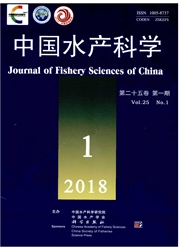

 中文摘要:
中文摘要:
菲律宾蛤仔(Ruditapes philippinarum)取自乳山湾东流区金港养殖区,其壳长范围为2.86-3.21cm。实验结果表明,温度为20℃时,菲律宾蛤仔氮的排泄率最大(11.381μg·h^-1·ind^-1),是其他温度组(10℃、15℃、25℃、30℃)的2~8倍。菲律宾蛤仔代谢产物中NH4^+-N占总无机氮的88%-91%,NO3^--N和NO2^--N占总无机氮的比例很小,分别为5.74%~7.89%和2.11%~4.01%,表明菲律宾蛤仔是排氨动物,氮的代谢终极产物主要为氨。磷的排泄随温度的变化不是很明显,排泄的磷中DOP的量明显小于DIP,总体趋势是随温度的升高略有增高,其中TDP和DIP变化幅度完全一致,DOP变幅相对较小,但上述3种形态P的水平随温度变化与N相比要小得多。通过实验分析表明,20℃时菲律宾蛤仔氮的排泄率最高。
 英文摘要:
英文摘要:
Nitrogen and phosphorus excretions of marine invertebrate are important to marine nutrient cycle. Bivalve belongs to filtering animals, having strong filter ability and playing an important role in energy transfer and matter cycle in coastal ecosystem, especially in the high density and large dimensions costal seashells culture area, because culture areas have been overexploited and the culture number of seashells culture has surpassed the carrying capacity. Besides, through the physiological activities such as filtering, feeding and excretion, long term of culture and high density of clams make negative effects on the coastal ecosystem, of which N and P excretions, especially the recycles of N(NH4^+-N) and P(PO4^3-P) excretions by sea bivalves have great effects on the phytoplankton yields. In this experiment, the impacts of high density bivalve culture on the entironment were studied and this experiment could provide basic data and scientific information to the healthy and sustainable development and biological recovery of aged seabeach for the seashell culture of the Rushan Bay. Nitrogen and phosphorus excretion by Ruditapes philippinarum in the Rushan Bay were studied under different temperature conditions( 10℃, 15℃, 20℃, 25℃, 30 ℃), the results showed the nitrogen excretion was especially high at 20℃(11.381μg/(h·ind)), which was 2-8 times as much as those in other different conditions. NH4^+-N excretion accounted for 88% -91% of TIN excretion. NO3^- N and NO2^--N were also examined but their proportions of TIN were very small, which were 5.74%-7.89% and 2.11%-4.01%, respectively. This indicated that bivalve ultimate metabolism substance is mainly ammonia. The phosphorus excretion had no evident change with temperature' s change. The phosphorus excretion increased a little with the temperature increasing and DOP excretion rate was lower than DIP' s. According to the result analysis, we found when the water temperature was 20 ℃ the nitrogen excretion rates of Rudita
 同期刊论文项目
同期刊论文项目
 同项目期刊论文
同项目期刊论文
 期刊信息
期刊信息
